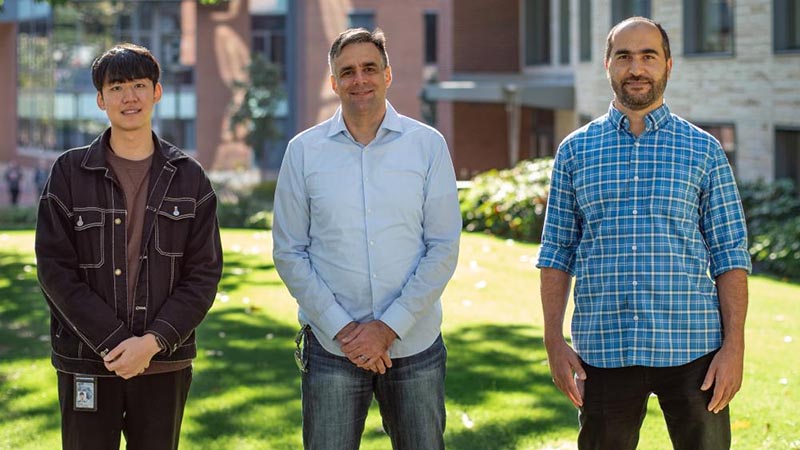
Penn State Professor of Chemical Engineering and Chemistry Bert Chandler, center, is the principal investigator on a $450,000 grant to research the use of gold as a catalyst for hydrogenation reactions. Akbar Mahdavi-Shakib (right), a postdoctoral researcher, and Tae Yong Yun (left), a second-year doctoral student in chemical engineering, will contribute to the project. IMAGE: KELBY HOCHREITHER
Going gold: Engineers to investigate using gold as catalyst in hydrogenation
11/10/2021
By Mariah Chuprinski
UNIVERSITY PARK, Pa. — Everyday items, like prescription drugs, gasoline and plastics, all undergo several rounds of catalytic processes during manufacturing. Industrial catalysis involves using a catalyst, a molecule or small piece of metal anchored to a solid matrix, to accelerate a chemical reaction while remaining unchanged. Scientists are continually looking for good catalysts that react with certain molecules but not others in order to reduce the energy needed to run the catalytic process.
In a three-year, $450,000 U.S. Department of Energy grant, Penn State researchers will study the use of gold as a catalyst to produce specific results through hydrogenation reactions. Hydrogenation is the process of adding hydrogen gas to a compound, a necessary step in manufacturing. A highly selective catalyst like gold could propel solutions to current engineering programs, according to Bert Chandler, Penn State professor of chemical engineering and chemistry and principal investigator on the grant.
“Hydrogenation reactions are pivotal components to a lot of green energy problems,” he said, noting potential applications in energy transport, storage, low-carbon energy processing, energy efficiency in chemical production and photocatalytic energy capture. “In this case, we don’t know how to make highly active and selective catalysts for some reactions. By working to understand how molecules react on gold catalysts, we believe we will be able to pose new solutions toward lessening the burden on the environment.”
Using gold as a catalyst is a relatively recent achievement in the scientific community, according to Chandler. Thirty years ago, Japanese scientist Masatake Haruta discovered that gold nanoparticles worked as a catalyst in carbon dioxide oxidation reactions. This finding contradicted thousands of years of chemistry research, which indicated that gold, in bulk, was chemically inert — it reacted with very few things.
“Gold is valuable because it is highly selective, reacting with one molecule but not another,” Chandler said. “This is a very desirable characteristic in lots of separation and purification processes in chemical engineering.”
Over the next few years, Chandler and his lab will use material synthesis and characterization to develop new catalytic reactions using gold, titanium dioxide and other metal additives as hydrogenation catalysts. Their long-term goal is to precisely understand the surface chemistry of gold to develop effective industrial separation and purification reactions.
“The problem with using gold in hydrogenation is that the gold catalysts are very slow, because hydrogen interacts very differently with gold catalysts than it does with more active metals like nickel or platinum,” Chandler said. “We believe that if we understand what makes it slow, and can tune the systems properly, we can improve its overall reactivity.”’
If the researchers are successful, the unique interactions between hydrogen and gold catalysts may facilitate such chemical reactions as those that breakdown waste plastics, Chandler said.
To this effect, Chandler also recently received a $375,000 grant from the National Science Foundation to investigate using gold catalysts to produce the chemical compound deuterium oxide, which may help facilitate smaller-scale and safer nuclear power plants. While the projects are separate, both aim to advance gold as a catalyst for a more sustainable future, Chandler said.
Catalysis has recently received increased attention due to its potential eco applications, according to Chandler. The 2021 Nobel Prize in Chemistry was awarded to catalysis researchers, for their work developing environmentally friendly catalysts with organic molecules. Chandler, who started his tenure at Penn State in January, is currently launching a catalysis research center at the University.
“One of the great things about catalysis, is in some ways it's the quintessential interdisciplinary science,” Chandler said. “It takes pieces from chemistry, physics, engineering and materials science, and uses all of them to do important, practical things like clean up car exhaust, convert light into energy or enable more energy-efficient reactions.”
Akbar Mahdavi-Shakib, a postdoctoral researcher, significantly contributed to securing the grant under difficult pandemic-related circumstances, according to Chandler. The duo previously worked together at Trinity University in San Antonio, Texas. Mahdavi-Shakib transferred to Penn State on Nov. 1. Tae Yong Yun, a second-year doctoral student in chemical engineering at Penn State, also will contribute to the project.



